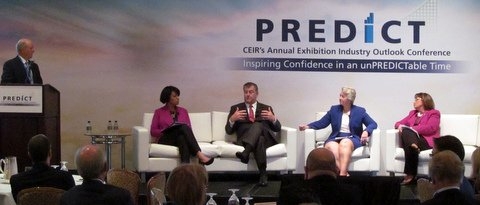Center for Exhibition Industry Research Predict Conference in New York Draws Record Crowd

At the 3rd Annual Center for Exhibition Industry Research’s Predict Conference, more than 150 C-level trade show industry leaders, M&A representatives, financiers, economists and sponsor suppliers gathered Sept. 12 in New York City and looked into a crystal ball to try and determine the future of the industry.
What they discovered was the overall sentiment in the room was one of cautious optimism.
While the U.S. trade show industry still is growing, it has slowed significantly, with GDP starting to surpass it.
Even so, compared with pressures around the globe, including continued stressors in the Eurozone, slowing growth in China and overall uncertainty in other regions, the U.S. looks to be a good bet.
Bain & Company’s Austin Kim opened the one-day event with a session that took a look at the overall global economic outlook.
“The global economy is still in a wrenching readjustment that has been building for three decades,” Kim said.
Some major shifts he pointed out that started in 1980 included the doubling of the labor force worldwide (driven by China), as well as Baby Boomers in the U.S. hitting their consumption peak in 2010, meaning they will be spending less.
He added that “developing markets in general are facing the pop of a multi-year bubble with China at the middle.”
The Eurozone, though, seemed to be in for the bumpiest ride since, according to Kim, the worst problems there won’t even materialize until the end of this decade.
Bright spots in the U.S. included sectors such as health care, energy, the ultra-cheap (like $10,000 cars made in India) and what Kim called ‘premiumization’, such as spending $3.00 for a 30 cent cup of coffee at Starbucks.
Even with the more bleak news worldwide, the U.S. trade show industry is on track to grow 1.3 percent this year, compared with last year, according to CEIR’s President and CEO Doug Ducate.
“Each year, we start out with a very optimistic outlook for the year until we get down to the fourth quarter,” he added.
Ducate said the CEIR Predict event was an important place for C-level trade show executives to be able to gather information on not only trends in the overall global economy, but also what’s happening in their peers’ business sectors as well.
A good portion of the day took a look at several different industry segments, including everything ranging from building and construction to retail to manufacturing.
Some of the good news included better times in residential building, one of the hardest hit markets during the recession.
The National Association of Home Builders’ CEO Gerald Howard said, “This is the best time to buy since 2003.”
He said the future also looked good with new housing starts climbing back up to 1.5 million units annually by 2015, after historic lows of around 400,000 units in 2008.
A new panel format this year brought in the mayors from four major cities – Dallas, Houston, Baltimore and Orange County, Fla. – for “City Talk”.
Dave Whitney from DRW Marketing, the panel’s moderator, kicked off the discussion by saying at least $36 billion worth of business was sitting in the room in front of the mayors, prompting Dallas Mayor Mike Rawlings to joke, “Well, let’s just split it four ways.”
Among several topics discussed were whether the cities were looking to cut back on marketing dollars, which they said no; what did they think of the situation in New York City where the state’s governor has interfered with show dates at Javits Center, which they all said politics should stay out of trade show industry; and all of them said it’s a tough sell to talk about upgrading the convention center product when the local citizens are more concerned about their own neighborhoods.
Even though there was a struggle at times, they all thought it was worth it to support the trade shows coming into their cities.
The luncheon keynote was author Clay Shirky, who wrote “Here Comes Everybody” in which he explains how he has long been in favor of crowdsourcing and collaborative efforts online.
He said a lot of people meet online, but then they went to get together and meet face to face. “Communication and transportation are complements to each other,” he added.
Shirky encouraged the show organizers in the room to tap into their own communities and allow them to flourish.
The day was capped off with a mergers and acquisitions and financing session, during which the $959 million buy of Emerald Expositions (previously Nielsen Expositions) by ONEX was discussed, as well as what the overall market looked like.
David Audrain, who co-chaired the event, made a surprise announcement at the end of the day that the Society of Independent Show Organizers, of which he also is the current chair, was going to donate $100,000 during the next five years to support the work of the CEIR Foundation.
Greg Ortale, who heads the Greater Houston Convention & Visitors Bureau, also led the group in saying thank you to Ducate, who will step down from his CEIR post at the end of the year.
“We couldn’t possibly have done all of this without you,” Ortale said.


Add new comment